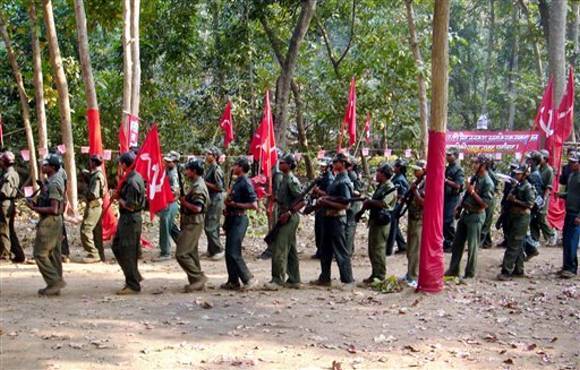Maoists Continue To Pose Internal Security Threat In India
The Maoists are using the time to regroup and strengthen internal organisational structures.

NEW DELHI: Two incidents this week serve as reminders that the Maoist threat in India is far from over. The first, a gun battle between Cobra jawans and Maoists insurgents in Chhattisgarh's insurgency-hit Dantewada district and two, an incident where a police team working near Horna village in South Chhattisgarh came under Maoist fire.
These relatively less grave incidents follow the killing of 16 security personnel belonging to a joint force of the national paramilitary Central Reserve Police Force (CRPF) and police, and the kidnapping of three panchayat level staff workers in Jharkhand by Maoists earlier this year.
The Maoists continue to pose a security threat in India, managing to to sustain their operations for close to 40 years and spreading into one-third of the country’s geographical area. In three decades, about 12,000 civilians and 3000 security personnel have been killed by the Maoists, with 2010 being the bloodiest year during which the Naxals killed 720 people. Since then, there’s been a decline in Maoist violence, with many analysts attributing this reversal to the success of sustained efforts by the security forces. Others however, believe that this trend presents a strategic move by the Maoists who are using this period for recruiting, recuperating, forming new alliances and ways for raising funds and acquiring weapons.
The decline in Maoist violence can be partly attributed to losses suffered in terms of killings and arrests of many in the top ranks of leadership. However, to claim that that this decline is reflective of Maoist presence weakening in their traditional support base is not only simplistic but also not representative of the ground reality.
The Maoists seem to be strengthening internal organizational structures, having set up Regional Bureaus which are divided into zonal and state-level jurisdictions for coordinated political and military mobilization. The “Look North East Policy” seems to have been strengthened by the formation of the Upper Assam Leading Committee and reports of Maoist organisational activities in upper Assam districts, leading to Chief Minister Tarun Gogoi requesting that Assam be included in government’s Integrated Action Plan. Further, the Maoists have formed close ties with two vital northeastern insurgent groups - the Revolutionary People’s Front (RPF) and the People’s Liberation Army (PLA).
In addition to the northeast, Maoist aspirations in Western India seem to have received a boost, with the agenda of establishing a “Golden Corridor Committee” to connect areas of Gujarat and Maharashtra acquiring a more concrete form. In Central India, too, Maoist influence has been strengthened by the formation of the North Gadchiroli Gondia Balaghat Divisional Committee’ comprising of strategically important areas of Gadchiroli, Gondia and Balaghat in Maharashtra and Madhya Pradesh.
The Maoists are also expanding their activities in the South, with cadres active in the region to establish a forest route from Wayanad district to Mysore district in Karnataka. Intelligence reports further reveal that the Maoists have been stepping up efforts to set up bases on the tri-junction of Karnataka, Kerala and Tamil Nadu.
In 2012, the Chhattisgarh-Orissa Border (COB) Committee was formed by the Maoists, strengthening the group’s organizational structure in the region. Maoist presence in North India seems to be part of the expansion plan, with Maoist leaders and cadres being arrested in Delhi and Haryana in the last few years. This is in line with the groups’ Urban Perspective Plan (UPP), the expansion of which has seen Maoist activities increase in urban areas such as Delhi, Mumbai, Pune, Hyderabad, Patna, etc.
While it is true that the Maoists have faced setbacks in their traditional strongholds of Abujhmad (Chhattisgarh), Saranda (Jharkhand), and Lalgarh (West Bengal), the decline in guerilla warfare is complemented by efforts to strengthen internal structures and expansion plans aimed at other regions.
There are also reports of Maoist groups in Chhattisgarh forming ties with the Pakistan-based Lashkar-e-Taiba (LeT). In an attack on 8 January 2013, grenades and ammunition made in Pakistan were recovered. In 2011, Indian intelligence agencies had stated that they had evidence to prove that Pakistan’s Inter-Services Intelligence (ISI) had established contact with Maoist groups in India.
Another dimension of the Maoist movement in India that has not received adequate government attention, there have been reports of Maoists in India forming connections internationally, with groups in Philippines, Turkey, Germany, France, Holland and Italy. The CPI(Maoists) are also part of the Coordination Committee of Maoist Parties and Organisations of South Asia (CCOMPOSA).
It is clear that the relatively low degree of violence from 2011-2013 should not be misinterpreted as the weakening of the Maoist movement in India or the success of the government’s changed strategy. The Maoists seem to be developing a long-term strategy based on strengthening their organizational structure, establishing networks - nationally and internationally, and expanding into other territories. The government’s response will also need a long-term vision, which is being compromised by a simplistic understanding of the decline in Maoist related violence in the past two years.



